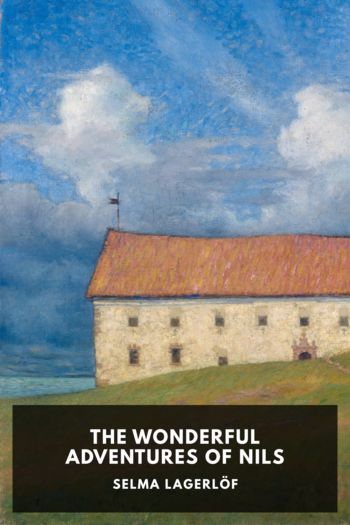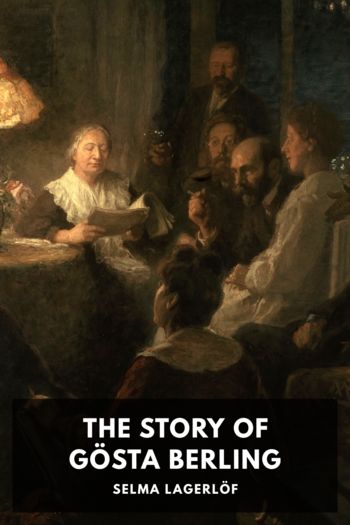The Wonderful Adventures of Nils by Selma Lagerlöf (i can read book club TXT) 📕

Description
In The Wonderful Adventures of Nils, Selma Lagerlöf tells the story of Nils Holgersson, a young boy who is transformed into an elf after a set of misdeeds. Escaping with his family’s farm goose he joins up with a flock of wild geese and travels with them across Sweden as they return to their annual nesting grounds in Lapland.
The story was originally written as a commission for the Swedish National Teachers’ Association to write a geography book for children and has become a firm favourite in the country. It’s been adapted for screen many times, translated into over 30 languages and, until recently, was the artwork on the 20 krona banknote.
Although originally published in English in two volumes—the second starting at “The Story of Karr and Grayskin”—here they are presented as a single combined story.
Read free book «The Wonderful Adventures of Nils by Selma Lagerlöf (i can read book club TXT) 📕» - read online or download for free at americanlibrarybooks.com
- Author: Selma Lagerlöf
Read book online «The Wonderful Adventures of Nils by Selma Lagerlöf (i can read book club TXT) 📕». Author - Selma Lagerlöf
She was from Vermland, and it was perfectly clear to her that she wished to begin the book with that province. First of all she would write about the place where she had grown up. It was a little homestead, far removed from the great world, where many old-time habits and customs were retained. She thought that it would be entertaining for children to hear of the manifold duties which had succeeded one another the year around. She wanted to tell them how they celebrated Christmas and New Year and Easter and Midsummer Day in her home; what kind of house furnishings they had; what the kitchen and larder were like, and how the cow shed, stable, lodge, and bath house had looked. But when she was to write about it the pen would not move. Why this was she could not in the least understand; nevertheless it was so.
True, she remembered it all just as distinctly as if she were still living in the midst of it. She argued with herself that since she was going into the country anyway, perhaps she ought to make a little trip to the old homestead that she might see it again before writing about it. She had not been there in many years and did not think it half bad to have a reason for the journey. In fact she had always longed to be there, no matter in what part of the world she happened to be. She had seen many places that were more pretentious and prettier. But nowhere could she find such comfort and protection as in the home of her childhood.
It was not such an easy matter for her to go home as one might think, for the estate had been sold to people she did not know. She felt, to be sure, that they would receive her well, but she did not care to go to the old place to sit and talk with strangers, for she wanted to recall how it had been in times gone by. That was why she planned it so as to arrive there late in the evening, when the day’s work was done and the people were indoors.
She had never imagined that it would be so wonderful to come home! As she sat in the cart and drove toward the old homestead she fancied that she was growing younger and younger every minute, and that soon she would no longer be an oldish person with hair that was turning gray, but a little girl in short skirts with a long flaxen braid. As she recognized each farm along the road, she could not picture anything else than that everything at home would be as in bygone days. Her father and mother and brothers and sisters would be standing on the porch to welcome her; the old housekeeper would run to the kitchen window to see who was coming, and Nero and Freja and another dog or two would come bounding and jumping up on her.
The nearer she approached the place the happier she felt. It was autumn, which meant a busy time with a round of duties. It must have been all these varying duties which prevented home from ever being monotonous. All along the way the farmers were digging potatoes, and probably they would be doing likewise at her home. That meant that they must begin immediately to grate potatoes and make potato flour. The autumn had been a mild one; she wondered if everything in the garden had already been stored. The cabbages were still out, but perhaps the hops had been picked, and all the apples.
It would be well if they were not having house cleaning at home. Autumn fair time was drawing nigh, everywhere the cleaning and scouring had to be done before the fair opened. That was regarded as a great event—more especially by the servants. It was a pleasure to go into the kitchen on Market Eve and see the newly scoured floor strewn with juniper twigs, the whitewashed walls and the shining copper utensils which were suspended from the ceiling.
Even after the fair festivities were over there would not be much of a breathing spell, for then came the work on the flax. During dog days the flax had been spread out on a meadow to mould. Now it was laid in the old bath house, where the stove was lighted to dry it out. When it was dry enough to handle all the women in the neighbourhood were called together. They sat outside the bath house and picked the flax to pieces. Then they beat it with swingles, to separate the fine white fibres from the dry stems. As they worked, the women grew gray with dust; their hair and clothing were covered with flax seed, but they did not seem to mind it. All day the swingles pounded, and the chatter went on, so that when one went near the old bath house it sounded as if a blustering storm had broken loose there.
After the work with the flax, came the big hardtack baking, the sheep shearing, and the servants’ moving time. In November there were busy slaughter days, with salting of meats, sausage making, baking of blood pudding, and candle steeping. The seamstress who used to make up their homespun dresses had to come at this time, of course, and those were always two pleasant weeks—when the women folk sat together and busied themselves with sewing. The cobbler, who made shoes for the entire household, sat working at the same time in the menservants’ quarters, and one never tired of watching him as he cut the leather and soled and heeled the shoes and put eyelets in the shoestring holes.
But the greatest rush came around Christmas time. Lucia Day—when the housemaid went about dressed in white, with candles in her hair, and served coffee to everybody at five in the morning—came as a sort of reminder that for the





Comments (0)